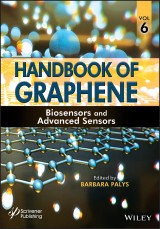Details

Handbook of Graphene, Volume 6
Biosensors and Advanced Sensors1. Aufl.
|
233,99 € |
|
| Verlag: | Wiley |
| Format: | |
| Veröffentl.: | 12.06.2019 |
| ISBN/EAN: | 9781119469759 |
| Sprache: | englisch |
DRM-geschütztes eBook, Sie benötigen z.B. Adobe Digital Editions und eine Adobe ID zum Lesen.
Beschreibungen
<p><b>The sixth volume in a series of handbooks on graphene research and applications</b><p>The <i>Handbook of Graphene, Volume 6: Biosensors and Advanced Sensors</i> discusses the unique benefits that the discovery of graphene has brought to the sensing and biosensing sectors. It examines graphene's use in leading-edge technology applications and the development of a variety of graphene-based sensors. The handbook looks at how graphene can be used as an electrode, substrate, or transducer in sensor design. Graphene-based sensor detection has achieved up to femto-levels, with performances delivering the advantages of greater selectivity, sensitivity, and stability.<br />
<p><b>Barbara Palys</b> received her PhD (1993) from University of Twente, the Netherlands and DSc (2008) from University of Warsaw, Poland. She is currently professor at the Faculty of Chemistry at the University of Warsaw and leader of the group "Materials for Biosensors" at the Biological and Chemical Research Centre of University of Warsaw. Her research interests include design and studies of surfaces, materials and nanostructures that can be used as matrices for deposition of enzymes; electrocatalytic properties of hybrid materials comprising graphene oxide, nanostructures of conductive polymers, supramolecular polymeric gels and metallic nanostructures as well as SERS applications of graphene oxide. She has authored more than 70 publications cited over 1300 times (H-factor =21).
<p><b>This unique multidisciplinary 8-volume set focuses on the emerging issues concerning graphene materials and provides a shared platform for both researcher and industry.</b> <p>Since the pioneering work of Geim and Novoselov, numerous articles have been published on the physicochemical properties of graphene. Methods for synthesizing graphene in large quantities are still a subject of extensive research. The search for novel applications of graphene has also received a great deal of attention. The high conductivity, large surface-area-to-volume ratio, and fascinating optical properties combined with excellent biocompatibility make graphene a remarkable candidate for application in biosensors. <p>Related materials like graphene oxide (GO) and reduced graphene oxide (RGO) are receiving increasing interest due to the abundance of surface groups, which can be utilized for the attachment of biospecies. Thanks to the chemical flexibility of the physical properties of these groups, like hydrophobicity or fluorescence of RGO, materials can be tuned to obtain optimal values for biosensor applications. All the properties of graphene, GO, and RGO are described in this book, which addresses many aspects relevant to the design of biosensors for application in a variety of fields ranging from clinical testing, environmental monitoring, and agriculture, to food analysis and quality control. <p>This volume 6 of <i>Handbook of Graphene</i> is devoted to <i>Biosensors and Advanced Sensors</i>. It comprises 26 chapters from internationally recognized researchers. Some of the important topics include but not limited to: Graphene for electrochemical biosensors applications in biomedical, agro-defense, pesticides; reduced graphene oxide for biosensing and electrocatalytic applications; electrochemical biosensor-based on green synthesized graphene and graphene nanocomposites; graphene-based nanomaterials; graphene-based fiber optic label-free biosensor; label-free biosensors based on graphene; graphene molecules as platforms for sers detection; graphene-based electrochemical aptasensors; self-organized 3D graphene as a robust sensing platform; interactions of molecular species with graphene and graphene sensing; self-assembled thin films of graphene materials for sensors; graphene and graphene nanocomposite-based electrochemical sensors; controlling the electromagnetic and electrochemical sensing properties of graphenes via heteroatom doping; finite element analysis of graphene materials; quantitative real-time evaluation of c/o ratios and stepwise control of deoxidization of graphene oxide using plasmonic-based electrochemical spectroscopy. <p><b>Audience</b> <p>This book is intended for researchers and graduate students in the field of advanced materials and graphene in particular, who are currently investigating the fundamental properties of this material and its applications in micro- and nanotechnologies.


















